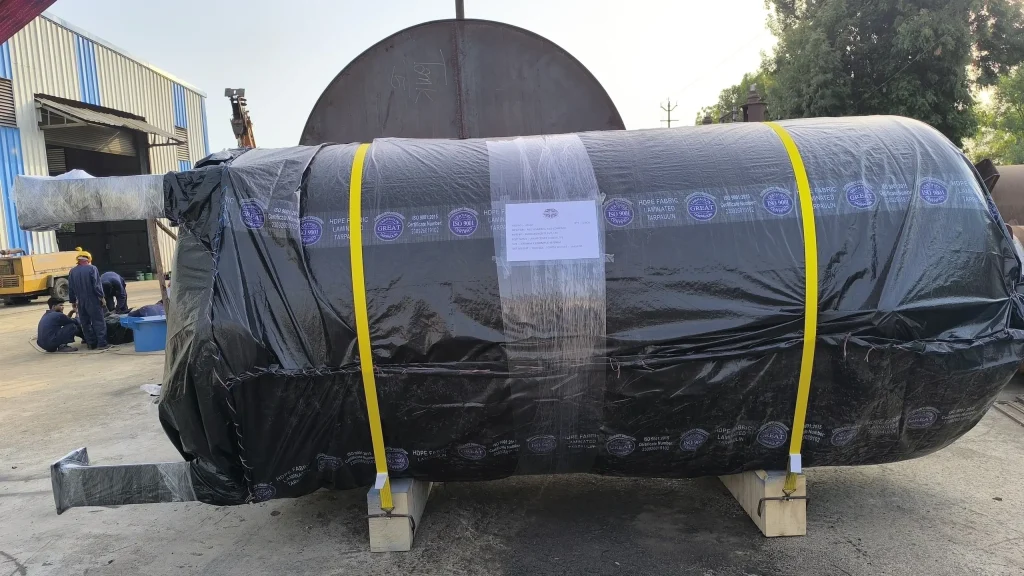A well-designed compressed air system relies on stable storage to absorb fluctuations, maintain pressure, and feed equipment without interruption. For facilities with continuous demand and large pneumatic loads, a 200-gallon air receiver becomes a central piece of infrastructure rather than an accessory. Its capacity supports steady tool performance, safeguards compressor life, and helps balance system pressure during production peaks. As you plan an upgrade or a new installation, you’ll want to understand configuration choices, moisture management, and safety standards that govern these tanks. If you’re exploring options or need assistance sizing for unique duty cycles, Contact us to review your application and constraints.
The Role of 200-Gallon Tanks in High-Volume Air Systems
In high-volume air systems, storage capacity functions as a stabilizer that smooths demand spikes and avoids harmful pressure sag at the point of use. A 200-gallon tank extends the time buffer between compressor cycles, letting tools draw down stored air without forcing an immediate start. This storage strategy protects against nuisance trips on pressure-sensitive equipment and supports consistent process quality. When the system is tuned correctly, operators gain predictable delivery pressure and fewer unplanned interruptions. The result is a more resilient network that keeps production moving even when demand briefly surges.
Buffering Demand and Supporting Tool Performance
The adequacy of storage can make or break system continuity during shift changes, batch operations, or concurrent tool actuation. By absorbing the top of the demand curve, a 200-gallon receiver reduces the amplitude of pressure swings at downstream manifolds. That stability minimizes chatter in regulators, prevents pressure-starved pneumatic cylinders, and maintains torque consistency in air tools. With correct placement and piping diameter, the tank responds quickly, keeping the header pressure inside a narrow band. Over time, this steadiness reduces scrap, improves cycle repeatability, and elevates operator confidence in the air supply.
Design Choices: Vertical vs Horizontal Tank Configurations
Selecting between vertical and horizontal tanks often comes down to space, service access, and how you intend to manage condensate. Vertical designs conserve floor area, fitting neatly into tighter mechanical rooms while simplifying gravity drainage to low-point valves. They also can encourage stratification that keeps bulk moisture at the bottom for easier removal. Horizontal tanks, on the other hand, offer a lower profile that can fit under mezzanines or along walls, and they typically provide more convenient mounting surfaces for accessories. Evaluating clearances for inspections, safety valve access, and piping runs is just as important as raw volume.
When Footprint Dictates Form
A vertical unit may be ideal when you need to stage a filter train beneath the vessel or when forklift and pedestrian traffic leave little side clearance. The horizontal alternative can shine on skids or packaged systems where compressors, dryers, and receivers are integrated. Either way, a well-specified 200 Gallon Receiver Tank should include ample ports for gauges, transducers, and drains to enable flexible layouts. Consider how you’ll route the inlet and outlet to minimize pressure drop while keeping maintenance points visible and reachable. Remember that base mounting, seismic hardware, and vibration isolation can differ by orientation, affecting both installation cost and compliance.
How Larger Tanks Enhance Compressor Efficiency and Life
A larger receiver directly influences compressor duty cycle by reducing the frequency of starts and stops, one of the most significant wear factors for many machines. Fewer starts lower inrush currents on motors, cut thermal stress, and keep lubricants within optimal temperature ranges. As the tank stores more usable air, the compressor can run longer, more efficient cycles rather than short bursts that barely reach steady-state operating conditions. That shift preserves valve integrity, reduces moisture carryover, and helps maintain stable discharge temperatures. Over months and years, these incremental gains add up to longer service intervals and a healthier compression train.
The Mechanics Behind Fewer Starts
When pressure bands are properly set, stored air bridges the gap between cut-out and cut-in without immediate motor engagement. The system avoids rapid cycling that can strain starters, overload relays, and drive up energy costs during acceleration. With a robust receiver, controls can target tighter pressure windows without risking starvation, improving process quality and reducing waste. It’s also easier to accommodate transient spikes from large pneumatic actuators because the storage acts as a shock absorber. The upshot is a calmer, more predictable operation that extends the life of both the compressor and downstream components.
Managing Condensation and Moisture in Extended Operations
Because air receivers act as thermal reservoirs, they naturally condense moisture as warm air cools in the shell. With a 200-gallon tank, residence time can be long enough to drop significant water load, making drainage strategy critical. Manual petcocks are rarely sufficient in production; automatic float or timer drains minimize labor and prevent waterlogging. Placing the receiver upstream or downstream of drying equipment changes its moisture role; upstream encourages bulk separation, while downstream offers buffer storage of conditioned air. Whichever path you choose, maintain easy access for inspection and routine tests to ensure reliable condensate removal.
Drainage, Separation, and Air Quality
Moisture management starts with thoughtful port placement and continues with the right mix of separators, coalescing filters, and desiccant or refrigerated dryers. A well-configured 200 Gallon Receiver Tank will include a low-point drain, sloped piping into the vessel, and provisions for oil-water separation to address environmental rules. Use differential pressure indicators on filters and periodically verify drain operation to catch failures before water reaches sensitive tools. Monitoring dew point gives early warning of dryer saturation, and protective coatings inside the vessel can help reduce corrosion risk. These practices protect valves, extend tool life, and keep quality standards intact in long shifts.
Pressure Ratings and Safety Standards for Industrial Tanks
Industrial receivers must meet rigorous pressure vessel codes, with ASME certification being the defining benchmark in many regions. Typical ratings for mid-size shop tanks range from 150 to 200 psig, but you should select a rating that aligns with compressor discharge and your highest required setpoint plus a comfortable margin. Safety devices—relief valves, gauges, and block-and-bleed provisions—must match the tank’s rating and be serviceable without taking the entire system offline. Regular inspections for corrosion, weld integrity, and fixture condition are as important as the original certification. Clear labels and legible nameplates simplify audits and prevent setpoint mistakes.
Testing, Labeling, and Compliance Essentials
Expect a compliant receiver to carry a code stamp, data tag, and documentation showing the manufacturer, maximum allowable working pressure (MAWP), test pressure, and year of construction. Hydrostatic testing establishes integrity above MAWP and verifies that the vessel can handle the design stress with an appropriate safety factor. Relief valves should be sized to pass the compressor’s maximum output, including any potential overspeed or unload failure conditions. Local jurisdictions may require periodic inspection logs and external coatings that resist chemical exposure or weather if the tank is installed outdoors. Staying current with these requirements keeps your workforce safe and helps avoid costly downtime.
Energy Optimization and Reduced Compressor Cycling
Energy performance improves when storage works in concert with intelligent controls, well-set pressure bands, and leak management. A larger receiver allows the compressor to operate closer to its best efficiency point, particularly in systems that otherwise short-cycle under variable demand. By shaving peaks with stored air, you reduce off-design operation and the frequency of transitions that draw high inrush current. This not only shows up in lower utility bills but also enhances reliability by limiting thermal and mechanical stress. Strategic placement of the tank can further lower line losses, keeping delivery pressure stable with less compressor work.
Setpoints, Storage, and System Controls
Dialing in the right differential between cut-in and cut-out pressures ensures you’re using storage effectively without causing excessive pressure swings. Sequencers and variable-speed drives can coordinate with the receiver to stage compressors optimally, reserving starts for when truly needed. Data logging of pressure and flow helps confirm that the tank size and control strategy are delivering measurable reductions in cycling. If you’re evaluating an upgrade or considering a new 200 Gallon Receiver Tank to capture energy savings, Contact us to model load profiles and validate ROI assumptions. Small control tweaks—like adjusting regulator placement or reducing unnecessary high-pressure zones—often unlock additional savings.
Integrating 200-Gallon Tanks Into Plant-Wide Air Networks
Integration success hinges on placement relative to major loads, pipe sizing, and the interplay of upstream treatment components. Positioning the receiver near high-intermittency workcells dampens localized pressure drops before they propagate through the header. Use generously sized connections and gentle routing to minimize pressure loss, and include isolation valves so the tank can be serviced without halting production. Where long runs are unavoidable, a central receiver can be paired with satellite vessels to stabilize far-flung drops. Instrumentation—pressure transmitters, temperature sensors, and flow meters—will give you the visibility needed to fine-tune performance.
Piping Layout and Instrumentation Tips
A thoughtful layout leverages the receiver as both a buffer and a node for controls, with takeoffs oriented to discourage moisture carryover into critical lines. Consider adding a check valve on the tank inlet to prevent backflow into the compressor during shutdowns or maintenance. If you’re standardizing equipment across multiple buildings, align port sizes and thread types so a spare 200 Gallon Receiver Tank can be swapped in with minimal rework. As operations evolve, the receiver provides a platform for expansion—extra ports accommodate additional regulators, dryers, or a master pressure sensor for centralized control. For assistance with tie-ins, code compliance, or future-proofing your air system, Contact us to collaborate on a plan that supports growth without sacrificing reliability.





More Stories
Air Compressor Maintenance Tips for Longer Equipment Life
How to Choose Between In-Person, Hybrid, or Virtual Events
Securing Business Spaces with Professional and Reliable Commercial Fencing Solutions